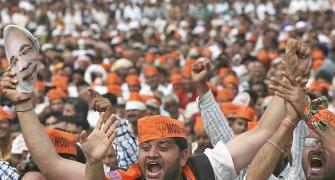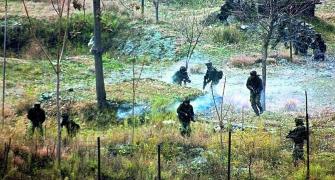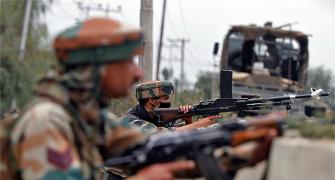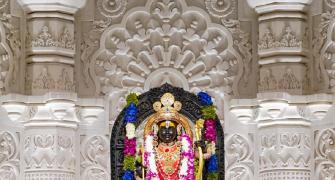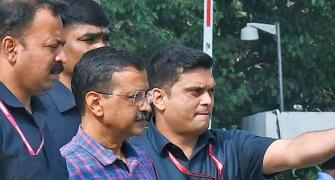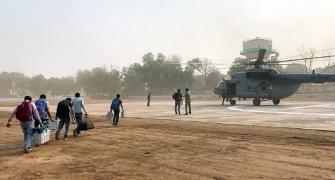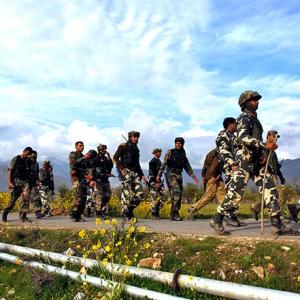'Throughout a quarter century of proxy war, India has shown tremendous restraint in the face of grave provocation.'
'It is inconceivable that any other nation would have refrained from launching trans-LoC operations to eliminate terrorist training camps and interdict known routes of infiltration,' says Brigadier Gurmeet Kanwal (retd).
.jpg?w=670&h=900)
The twin terror attacks at Kathua and Samba in the Jammu division of Jammu and Kashmir on March 20-21, 2015 provide a clear indication that Pakistan's quarter century old 'proxy war' against India will continue unabated.
In a carefully drawn up strategy to bleed India through a thousand cuts, Pakistan launched a proxy war against India in J&K in 1989. During these 25 years, the insurgency has waxed and waned; there were many peaks and several troughs.
Over the last decade, the security forces have managed to eliminate most of the terrorists and have ensured that the people can lead normal lives. The remaining roots of the insurgency are now in Pakistan and Pakistan occupied Kashmir, PoK.
Politically, successive governments in New Delhi have been remiss in allowing the challenge in J&K to linger on and not dealing with it with the urgency and sensitivity that it merits.
Having tasted some success in adding fuel to the fire of separatism in Punjab in the 1980s, the 'deep State' in Pakistan decided to extend its proxy war to J&K.
The first militant outfit to be supported by the Pakistan army and the Inter-Services Intelligence Directorate, ISI, and given shelter in PoK was the Hizbul Mujahideen, HM, that comprises Kashmiri youth and is closely affiliated with Pakistan's Jamaat-e-Islami.
It is led by Syed Salahuddin, who had been defeated in the rigged election to the J&K assembly in 1987. Since then, the Lashkar-e-Tayiba, LeT, the Jaish-e-Mohammad, JeM, and the Harkat-ul-Mujahideen, HuM, all Pakistani terrorist organisations, have acted as the 'strategic assets' and the ISI's sword arms in fomenting trouble in J&K.
Pakistan has been inciting the disaffected youth of J&K to rise against the Indian State. Despite the cease-fire on the LoC since November 2003 and the efforts at rapprochement, the ISI continues to sponsor infiltration across the LoC and coordinate the launching of terrorist strikes.
Pakistan's official position has always been that it provides only 'diplomatic, political and moral' support to Kashmiri 'freedom fighters.' However, it is now internationally accepted that the ISI has been providing training, weapons, intelligence, military equipment, ammunition and explosives and financial support to the terrorists.
The Pakistan army has been aiding infiltration attempts by engaging Indian Army posts with artillery and small fire arms.
In the first few years of militancy in the Kashmir valley, the militants had received local sympathy due to the people's perceived grievances against the Indian State. The Kashmiri people were soon disillusioned by the brutal and un-Islamic terror-tactics of the so-called mujahideen.
The leadership soon passed into the hands of international mercenary terrorists from Pakistan, Afghanistan, Iran, Saudi Arabia, Iraq, Libya, Sudan, Turkey and even Bosnia.
They had everything else but jihad on their minds. They exploited the power of the Kalashnikov to indulge in extortion, drinking orgies, forced weddings and even rape. Some of them were prisoners on death row or those serving a life term who were given the option to operate in J&K for six months and go scot free on return.
Systematic ethnic cleansing directed by the ISI resulted in the forced migration of the Hindu population out of the Kashmir Valley. The displaced Hindus became refugees in their own country. Some of them are still living in refugee camps.
Activities of the mercenaries contrary to Kashmir's Sufi culture caused immense resentment among the people and gradually the recruitment base began to dry up. The people became increasingly disillusioned with the terrorists.
Concerted counter-insurgency operations conducted by the Indian Army and the other security forces, based on the increasing availability of real-time 'actionable' intelligence from the Kashmiri people, decimated the terrorists and brought the internal security situation under control by 1995, 1996.
Frustrated in their efforts to create a popular uprising in Kashmir in 1996, the Pakistan army and the ISI evolved a plan to enlarge the area of operations to the Jammu region south of the Pir Panjal Range. By mid-1998, the security forces were again in complete control of the security situation in J&K and the state was rapidly returning to normal.
In a last ditch attempt to re-kindle the almost dead embers of insurgency, the Pakistan army pushed in a large number of regular soldiers under the guise of Kashmiri militants across the LoC into the Kargil sector during the spring of 1999.
This resulted in the Kargil conflict in which the Indian Army fought relentlessly to push the intruders back across the LoC.
Since then, Pakistan has kept the pot simmering and the infiltration machinery well-oiled so that it can raise the ante when required.
The continuing alienation of the Kashmiri people from the national mainstream is a cause for concern. While successive prime ministers have taken several laudable initiatives, including the appointment of task forces and holding of talks with the political leaders -- leaders of the separatist Hurriyat Conference refused to participate -- there has been marked slackness in following through.
Loose talk about removing AFSPA and abrogating Article 370 of the Constitution -- the glue that binds the Constitutions of J&K and India -- continues unfettered. Except for a very small minority that has been deeply influenced by radical extremism, the Kashmiri people do not wish to either join Pakistan or opt for independence from India.
With a BJP-supported and PDP-led coalition government now in power, it is time to renew efforts to find a solution to the problem. After very hard and acrimonious bargaining, the Kashmiri people will ultimately settle for autonomy.
They will accept that the central government continues to deal with defence, foreign affairs, currency and communications while the J&K assembly is left free to legislate on everything else. This should not be viewed as an out of the way concession as federalism forms the basis of the Indian Constitution.
The late prime minister P V Narasimha Rao had said the 'sky is the limit' for autonomy. When asked whether negotiations would be within the framework of the Constitution, former prime minister Atal Bihari Vajpayee had said he would hold talks within a 'humanitarian framework.' Then prime minister Manmohan Singh had made a pitch for 'mutual tolerance, understanding and accommodation' in his first term.
Throughout a quarter century of proxy war, India has shown tremendous restraint in the face of grave provocation.
It is inconceivable that any other nation would have refrained from launching trans-LoC operations to eliminate terrorist training camps and interdict known routes of infiltration.
The Indian political leadership took risks to hold out an olive branch to the military and civilian rulers of Pakistan during the Vajpayee and Manmohan Singh regimes.
Unless the Pakistan army and ISI are willing to back a negotiated political solution to the Kashmir dispute, India and Pakistan will remain at loggerheads for many years to come.
And blood will continue to mingle with the waters of the Jhelum and other Kashmiri rivers.
Brigadier Gurmeet Kanwal (retd) is former Director, Centre for Land Warfare Studies, New Delhi.

